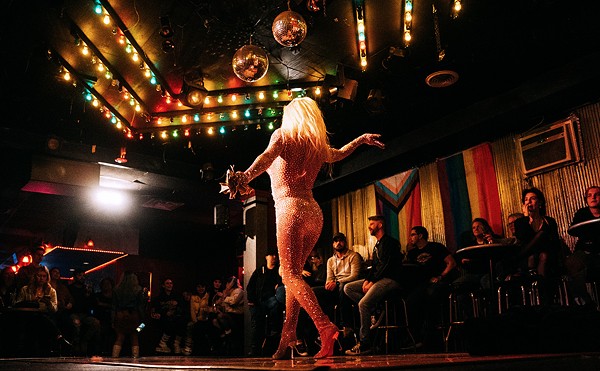|
Two gods make up the Jamestown settlement epic The New World, a movie that's often too beautiful for words. Colin Farrell puts his bedroom eyes and wild-man looks to the test as Captain John Smith, the rebellious Jamestown colonist who establishes first contact in 1607 with the native Powhatan Indians of the Virginia territory. Using body language and long glances, Farrell's lofty task is to come off as the type of man a young native girl would look at and consider a god.
The girl in his sights is the Powhatan princess Pocahontas, played by first-time actress Q'Orianka Kilcher. She's as innocent and beautiful as the role requires, perfectly capturing the awe Pocahontas feels for Smith. You see it in her dark eyes and expressive mouth. Her actions, putting her own life in jeopardy in order to save Smith, are true to her feelings.
Pocahontas and Smith share little dialogue with each other; they don't need to. Like many great love stories, they communicate with their hearts, minds and ultimately their bodies. The picture they make together tells their story well.
The other god who's key to The New World is elusive in front of and behind the cameras. He's a mystery, someone who grants few interviews. Terrence Malick has been making feature films since 1973 but The New World brings his total to a measly four. Yet every film — including Badlands, Days of Heaven and his World War II drama The Thin Red Line — is a work of exquisite beauty and a tale of deep meaning. They're movies like no other. It's no wonder that Malick, despite the heartache he creates with his plodding work habit, is treated like a god. For moviegoers who zigzag their way through action blockbusters and showbiz gossip, who scream out that films are art despite the foolishness of their cries, Malick stands out as the one filmmaker willing to suffer for his art. He's the director as martyr and, for that reason alone, he's a cinematic god.
The last breath of the Native Americans' Old World includes fields, harbors and dense forests. The New World brought by the English settlers involves gunpowder, stockades and settlement walls. Jamestown is a corporate endeavor by English investors, a chance to become wealthy. It's also a military excursion in search of new routes for traveling the globe. The natives are obstacles to both agendas.
The New World takes place 1607, but Malick wrote the script in the early 1970s at the height of Vietnam War protests and the American Indian Movement's occupation of Wounded Knee battlefield. Its anti-settlement themes are intentional and clear from the film's early scenes. There are villains in The New World; they're us.
The contact between Native Americans and English settlers in 17th-century Virginia forms the basis of the film, but the love triangle among Smith, Pocahontas and fellow settler John Rolfe (Christian Bale) overcomes the history lesson.
Everything about The New World speaks to a distant past, the first days of colonial America. In terms of period details, the roughhewn wardrobe worn by the settlers, their small sailing ships and muddy settlements, the natives' face paint and villages, everything is picture perfect. But The New World is a romance, one that happens to involve famous people and a key moment in American history. The details are a means for looking closely into Pocahontas' heart.
Natural light covers every image in the film. The outsider filmmaker uses handheld cameras to gain intimacy with the characters. The New World is a cinematic time capsule, a throwback to an era when movies were works of art. Comparisons to German filmmaker F.W. Murnau and his film Tabu are fair. What's difficult is finding an American contemporary of Malick's; a point of reference who might help explain the type of movie The New World is. The emerging filmmaker David Gordon Green is one true peer with his dramas George Washington, All the Real Girls and Undertow. But Green is committed thus far to intimate tales, small slices of life. Malick's unbelievable feat is weaving his intimate human portraits across an epic canvas of larger-than-life moviemaking.
With The New World, Malick takes the most familiar of tales, Pocahontas, and pushes it beyond the Disney version and elementary classroom treatment. He gives ample time to Pocahontas' conversion to Christianity, her new life as Lady Rebecca and wife of John Rolfe and her visit to England and the court of King James I.
Farrell stands out as the rebellious adventurer who captures Pocahontas' heart and leads her away from her tribe. But the true romantic hero of the movie is Rolfe, played to subtle perfection by Christian Bale. Rolfe treats Pocahontas as more than a pretty native princess, an exotic bauble that makes one's heart beat fast. He loves her and wants to make a life with her. Their story might not make for exciting adventure, but it's the source of great art.
The New World unfolds like a long walk in the woods shared by two lovers. It's a movie for those who make time for such walks. Of course, that's a select audience. Grade: B+





